The following information is from the CGBD Deep Dive that was previously provided to subscribers of Premium BDC Reports along with revised target prices, dividend coverage and risk profile rankings, potential credit issues, earnings/dividend projections, quality of management, fee agreements, and my personal positions for all business development companies (“BDCs”).
CGBD Risk Profile Update
CGBD’s portfolio remains mostly invested in true first-lien assets accounting for 70% of total investments (not including Credit Fund) highly diversified by borrower and sector, access to an experienced credit quality platform and historically low non-accruals.
“We consider our BDCs portfolio to be extremely well positioned fundamentally against this macroeconomic backdrop. We have roughly 70% of our portfolio in true first lien instruments. A high degree of investment diversification and significant under weights to more cyclical industry exposures, all of which we believe will be long-term benefits to our shareholders. We’re acutely aware that we’re investing in what could be late cycle and therefore we remain ultra-selective. Carlyle’s credit investment platform has over 100 investment professionals that have the expertise to evaluate opportunities across the capital stack, company sizes, sectors and market cycles all with the lens and relative value and fundamental credit investing.”

It is important to note that CGBD management conservatively values its portfolio each quarter:
From previous call: “When we held our initial earnings call as a public company back in August of 2017, I highlighted that based on our robust valuation policy, each quarter you may see changes in our valuations based on both underlying borrower performance as well as changes in market yields and that movement evaluations may not necessarily indicate any level of credit quality deterioration.”
As mentioned in the previous report, “my primary concern is 10.6% of the portfolio considered Internal Risk Rating 4”. During Q3 2019, NAV per share declined by 2.8% or $0.48 per share due to net realized/unrealized losses of $0.59 per share mostly from completely writing off its non-accrual investment in Dimensional Dental Management ($0.34 per share of unrealized losses) and additional markdowns of ‘watch list investments including Derm Growth Partners ($0.16 per share of unrealized losses). I am expecting a meaningful NAV decline due to Derm Growth Partners that will likely be added to non-accrual status in Q1 2020 (or earlier) and management discussed on the call:
Q. “Okay, thank you. Could you also talk about, I think, Derm Growth Partners III, that’s something another one that you’re carrying, bit of a discount to costs. I’m not sure if there’s something incremental that happened this quarter or if you could just give an update on the company. Thank you.”
A. “Yeah, the update I’d give on that credit is we’re working through some operational and financial performance challenges with the sponsor and the company, but unlike some of the other positions such as dimensional which was the other large mark down this quarter. This is a first lien tranche, so we expect in the situation a very different outcome than we had on dimensional which obviously being junior debt, in a underperforming situation, the recovery prospects on that one is much difference, that’s an important distinction I would draw between the two borrowers.”
Derm Growth Partners accounts for around 4% of CGBD’s NAV per share and I am expecting the company to default in 2020:

Dimensional Dental is one of the remaining investments from its “legacy last out program” which are first lien/last out loans with a secondary priority behind the first lien/first out loan with respect to principal, interest and other payments.
“Regarding valuations in NAV, our total aggregate realized and unrealized net loss was about $36 million for the quarter. One borrower Dimensional Dental contributed over half of this loss and over two-thirds of our NAV decline. As we marked our position down to almost zero. This company’s financial prospects of deteriorated materially over the last quarter. Given we hold a junior debt tranche we expect minimal recovery on our investment. This is one of the remaining credits from a legacy last out program, which is not made any new investments since 2017. And I know we’re making a conscious effort to reduce exposure in that program over the next few quarters. Regarding exits, we noted on last quarter’s call that we sold our investment in Totes. The realized loss of $11 million for the quarter primarily represents of reversal of prior period unrealized losses on this position.”
Product Quest Manufacturing was responsible for previous NAV declines and is also part of legacy last out program which I am expecting to be completely written off resulting in realized losses of $33 million or $0.56 per share but has already been mostly written off and will not materially impact upcoming NAV per share. Dimensional Dental and Product Quest were discussed on the recent call with management mentioning “going forward we’ve got residual exposure that came from that program, but we’ve got a really good line of sight to fully exiting”:
Q. “It looks like a couple of your more severe experiences have come from the Madison Capital joint venture, the last out program. Is there any thread there in hindsight, whether it’d be industry or structure? And is there a change on how you look at this avenue going forward?”
A. “Yes, something that we’ve talked a lot about as a team here. So when we started out, we had the program with Madison Capital that essentially was a first out last out program where Carlyle took the last out. We’ve stopped investing through that program back in 2017. We’re still working through some of the legacy issues that came through that program and you saw mainly in dimensional dental this quarter. I think one thing, I’m not sure I would blame it on necessarily an industry, where there is a little bit of that, but it’s more so the structure. A last-out position when as company gets into trouble and has to restructure its balance sheet. The recoveries there are tend to be relatively poor. And so that’s the main driver for us wanting to not continue to invest in that program, and I think more importantly going forward we’ve got residual exposure that came from that program, but we’ve got a really good line of sight to fully exiting, whether it’s through just getting repayments or sales or just general portfolio management.”
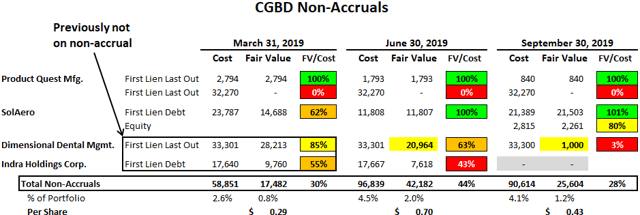
SolAero Technologies Corp. has been discussed in previous reports and was restructured during Q2 2019. As discussed in the previous report, there was around $11 million or $0.18 per share of realized losses during the quarter mostly due to exiting Indra Holdings Corp. (Totes Isotoner) that was previously on non-accrual status. However, non-accruals declined from 2.0% to 1.2% of the portfolio fair value.
From previous call: “We exited one of these positions [Totes] post quarter end at a level a bit lower than our 6/30 mark, driven by our developing view on the potential downside to our recovery in that investment. For the other non-accrual transactions these continue to be fluid and developing situations. Given the status of ongoing negotiations between the various parties we’re limited in providing additional color, but we hope to have updates over the next couple of quarters.”
TwentyEighty Investors was an investment that was previously restructured but mostly repaid in Q3 2019 and management expects to recover “over 100% of our original loan investment”:
“On a positive front, in September we receive repayment in full on our debt investment in TwentyEighty Investors, and in the last week we received equity proceeds from the sale of the remaining business lines. This was a loan we restructured back in early 2017 and with the right combination of capital, corporate governance and patients we expect to recover over 100% of our original loan investment.”
Some of the other investments that have been discussed in previous reports and/or that I am watching closely include Derm Growth Partners, PPT Management Holdings, Superior Health Linens, SPay, Inc., Legacy.com, Hydrofarm, Hummel Station, and GRO Sub Holdco. Most of these investments were marked down during Q3 2019 with the exceptions of Spay and GRO:
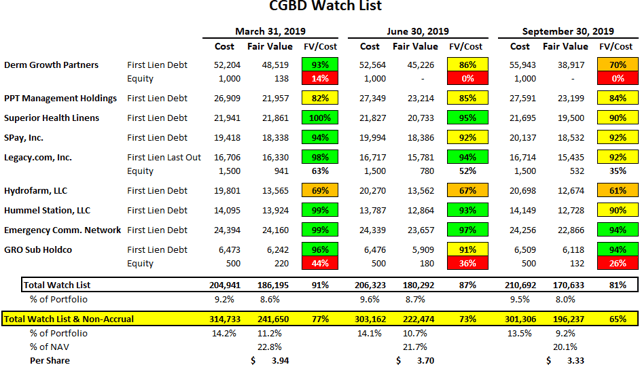
These losses were partially offset by over-earning the dividend by $0.08 per share and accretive share repurchases adding around $0.04 per share. The company repurchased another 1,168,383 shares during Q3 2019 at $14.69 per share (14% discount to previous NAV) resulting in accretion to net assets per share of $0.04. On November 4, 2019, the Board authorized a 12-month extension of its $100 million stock repurchase program at prices below reported NAV per share. The stock is still trading at 20% discount to its September 30, 2019 NAV and there will likely be additional accretive repurchases.
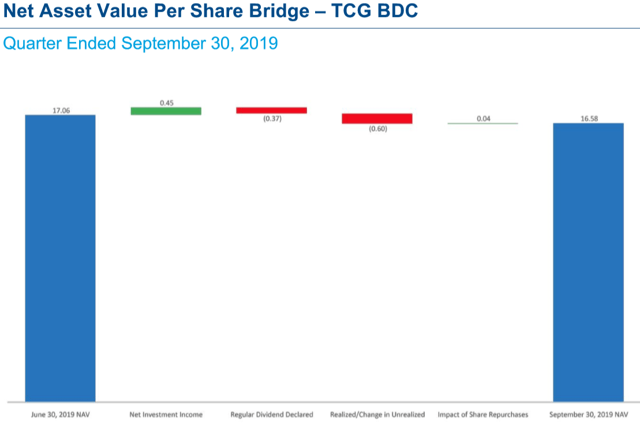
Over the last two quarters, payment-in-kind (“PIK”) income has increased from 2.1% to 4.3% partially due to ‘watch list’ investments including Superior Health Linens and Legacy.com, Inc. and needs to be watched:
“In both those scenarios, we had covenant issues and in the negotiations with the sponsor in inking an amendment, we were able to increase price and, in both cases, we increased the price in the form of PIK.”

As mentioned in the previous report, my primary concern is the amount of the portfolio considered ‘Internal Risk Rating 4’ defined as “Borrower is operating more than 20% below the Base Case and there is a high risk of covenant default, or it may have already occurred. Payments are current although subject to greater uncertainty, and there is moderate to high risk of payment default.” However, management discussed these investments on the previous call as “these are temporary performance issues” and “our goal remains full recovery”. Management mentioned that the recent credit issues are “idiosyncratic credit issues, not indications of either thematic risk concentrations in our portfolio or broad economic weakness”:
“Let me shift to a slightly deeper discussion on our portfolio and change in NAV this quarter. Our BDC’s portfolios highly diversified and heavily weighted with first lien positions, which represent about 70% of our portfolio as of the third quarter. We have over 140 investments in the portfolio diversified by size and sector. No single sector accounts for more than 12% of the portfolio. This portfolio construction represents our defensive approach to sustainable dividend creation, which is our investment objective. However, portfolio construction alone does not immunize the portfolio from idiosyncratic risk, but we expect to outperform the industry over the long-term. Our results this quarter were negatively impacted by a couple of investments that drove the vast majority of the 2.8% quarter-over-quarter decline in NAV per share this quarter.”
“We have aggressively moved to manage our remaining risk leveraging the broader Carlyle Global Credit workout team and other platform capabilities. As I mentioned last quarter, our team is focused on stabilizing NAV through prudent underwriting standards and active portfolio management. We are confident we can deliver strong long-term credit performance and drive shareholder value. So any individual quarter may exhibit some level of volatility. The core tenants of our investment philosophy are unchanged. We continue to invest in the best relative value opportunities maintain a strong bias toward senior debt and defensive industry exposures and directly originated from sponsors with whom we have meaningful relationships.”
“Regarding the overall portfolio, the weighted average internal risk rating remained 2.3 and the total watch list was flat quarter-over-quarter with no new additions. From a credit perspective, the key metrics for new originations remain largely in line with our broader portfolio in prior quarters. The loan to value was under 50%, the average leverage multiple was roughly 5.5 times. Average EBITDA was $90 million, significantly higher than our average portfolio EBITDA reflecting progress both deploying our scale capital more effectively as well as inroads made displacing syndicated market.”
From previous call: “We have dug into each situation and ascertained they represent idiosyncratic credit issues, not indications of either thematic risk concentrations in our portfolio or broad economic weakness. As you would expect, these loans are a significant focus for our team and we have committed the necessary resources to maximize shareholder value. For the most part, for the names that are on our watch list or on non-accrual, they’re idiosyncratic situations. But one thing we can point to is that within the healthcare services space, where we’re seeing companies do more aggressive types of roll-up transactions that those come with more challenges.”

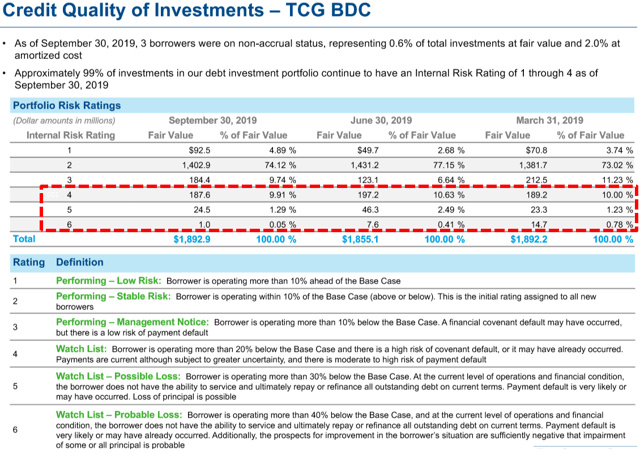
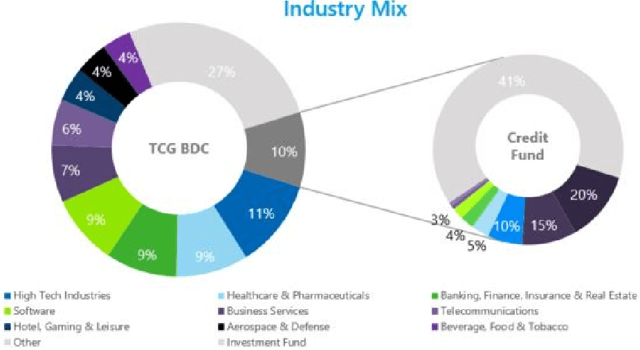
This information was previously made available to subscribers of Premium BDC Reports, along with:
- CGBD target prices and buying points
- CGBD risk profile, potential credit issues, and overall rankings
- CGBD dividend coverage projections and worst-case scenarios
- Real-time changes to my personal portfolio
To be a successful BDC investor:
- As companies report results, closely monitor dividend coverage potential and portfolio credit quality.
- Identify BDCs that fit your risk profile.
- Establish appropriate price targets based on relative risk and returns (mostly from regular and potential special dividends).
- Diversify your BDC portfolio with at least five companies. There are around 50 publicly traded BDCs; please be selective.

